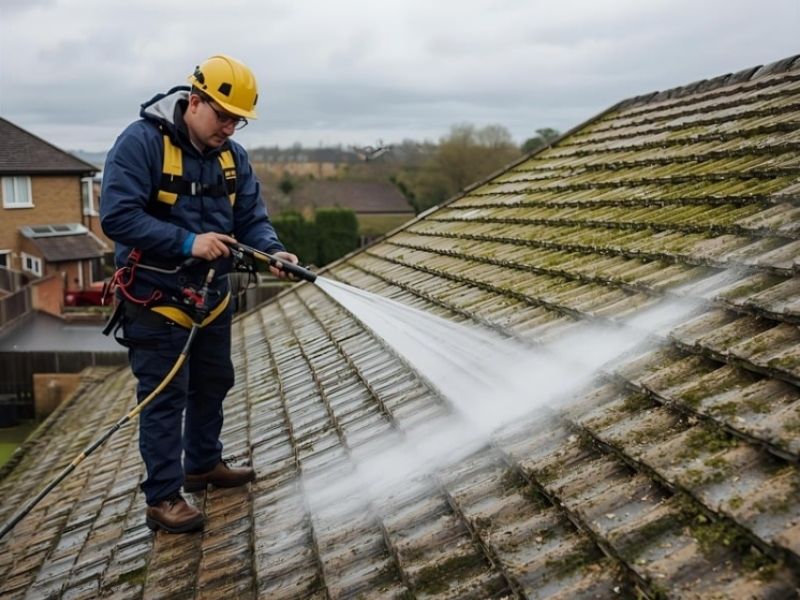
Moss on your roof is more than a cosmetic issue. It holds water against tiles, adding hundreds of kilograms to your roof structure and accelerating wear. Left unaddressed, that moisture can freeze in winter, cracking tiles and shortening your roof's lifespan by years. Whether you own a domestic property or manage a commercial building, understanding how to clean roof moss properly protects your investment and prevents costly repairs.
At Roof Cleaning Newcastle, we help property owners across the region tackle moss growth safely and effectively. This guide walks you through the most reliable methods, the tools you need, and how to keep your roof clear for years to come.
Moss thrives in damp, shaded environments where sunlight struggles to reach. North-facing roofs, properties surrounded by overhanging branches, and areas with high rainfall create ideal conditions for moss to take hold. Once established, moss can absorb up to 20 times its weight in water, trapping moisture against roofing materials and causing long-term damage. Knowing the best time of year to remove moss from roof surfaces can make treatments more effective and longer lasting.
Moss covered roof surfaces allow water buildup that seeps under tiles, leading to leaks, rot, and structural issues. Clogged gutters from moss and other debris contribute to water damage in around one in five UK homes each year. On commercial properties, the problem scales up quickly across large roof areas, making regular maintenance critical.
Understanding why moss grows helps you prevent future problems. Trees near your building create shade and drop leaves that decompose into organic matter, feeding moss spores. Clay tiles and asphalt shingles provide textured surfaces where moss roots easily. Even metal roofing materials can develop moss if conditions are right.
Spotting moss early makes the removal process simpler. Look for green or black patches spreading across roof tiles, particularly on sections that face north or receive less sunlight. Moss often appears first along the edges of shingles or in valleys where water collects.
Check your gutters regularly. Loose debris including moss fragments, leaves, and sediment indicates moss is breaking down and washing off the roof. Blocked downpipes and overflowing gutters during rain suggest the drainage system is compromised.
From ground level, use binoculars to inspect your roof every few months. Dark streaks, visible moss growth, and discoloured sections all signal it's time to act. Inside your property, damp patches on ceilings or walls may indicate water is penetrating through moss-damaged areas.
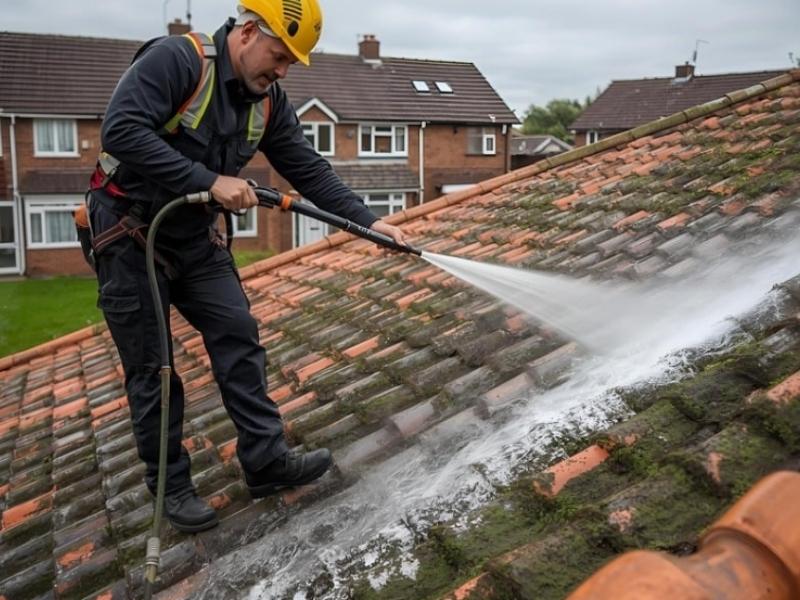
Working at height is dangerous. Around 65 to 70 percent of homeowners hire professionals rather than risk injury. If you choose to clean your own roof, take proper precautions.
Use a sturdy ladder secured at the base and top. Never lean ladders against gutters, which can break under weight. Wear safety harnesses attached to a solid anchor point if you need to walk on the roof surface. Non-slip footwear with good grip is essential, especially on wet or mossy areas.
Check weather forecasts before starting. Wind, rain, or frost make roofs treacherous. Work on a dry day with calm conditions. Avoid stepping directly on moss, which is extremely slippery even when dry. Distribute your weight across roof structure rather than balancing on individual tiles.
Keep others away from the work area. Falling debris, tools, or cleaning chemicals pose risks to anyone below. Cordon off the space beneath the roof edge and warn family members or colleagues before you begin.
Proper equipment makes moss removal safer and more effective. Basic tools include a garden hose with adjustable nozzle, stiff brush or broom, and a leaf blower for clearing loose debris. For chemical treatments, you'll need a spray bottle or garden sprayer.
Moss killer products come in several types. Homemade moss killer made from white vinegar and dish soap offers a natural alternative, though it requires more applications than commercial biocides. Ready-mixed treatments contain stronger active ingredients that kill moss and prevent regrowth for longer periods.
If you're considering pressure washing, use a model with adjustable settings. High pressure damages roof tiles by stripping protective coatings and forcing water under shingles. Soft wash systems with low-pressure water and cleaning chemicals provide safer results.
Metal strips made from zinc or copper offer long-term prevention. Rainwater washes metal particles down the roof, creating a surface where moss struggles to grow. Installing zinc or copper strips along the ridge provides ongoing protection with minimal maintenance.
Scraping moss by hand removes visible growth immediately but requires physical effort. Start by removing loose debris with a leaf blower or soft brush. Work from the top of the roof downwards, allowing debris to fall to the ground rather than pushing it into gutters.
Use a stiff brush or plastic scraper to lift moss from roof shingles. Metal tools can scratch and damage tiles, so avoid them. Work gently, especially on older roofing materials that may be brittle. The goal is to dislodge moss without harming the surface underneath.
Manual scraping clears most of the visible moss, but roots remain embedded in the roof structure. Without follow-up treatment, regrowth can occur in as little as 6 to 12 months. This method works best as the first step before applying moss killer.
Collect the moss you remove and dispose of it properly. Don't let it wash into gutters where it will cause blockages. Bag it up for garden waste collection or add it to compost piles away from your property.
Treating moss with chemicals kills existing growth and prevents it from returning. Biocides specifically designed for roofs offer the most reliable long-term results, keeping the roof remains moss free for four to six years after application.
Apply moss killer on a dry day with no rain forecast for at least 24 hours. This gives the product time to absorb into the moss and work effectively. Mix according to manufacturer instructions and use a spray bottle or garden sprayer to coat affected areas thoroughly.
Commercial moss treatments contain ingredients that kill moss and inhibit future growth. Follow safety instructions carefully, wearing gloves and eye protection when handling harsh chemicals. Keep children and pets away from the area during application and until the roof is completely dry.
Homemade moss killer combines white vinegar and dish soap in equal parts. Spray this mixture onto mossy areas and leave it to work for several hours. While gentler than commercial products, homemade solutions need more frequent applications and take longer to show results.
After applying any moss killer, wait for the moss to turn brown and die before brushing it off. This usually takes two to four weeks depending on the product and weather conditions. Rushing the cleaning process reduces effectiveness.
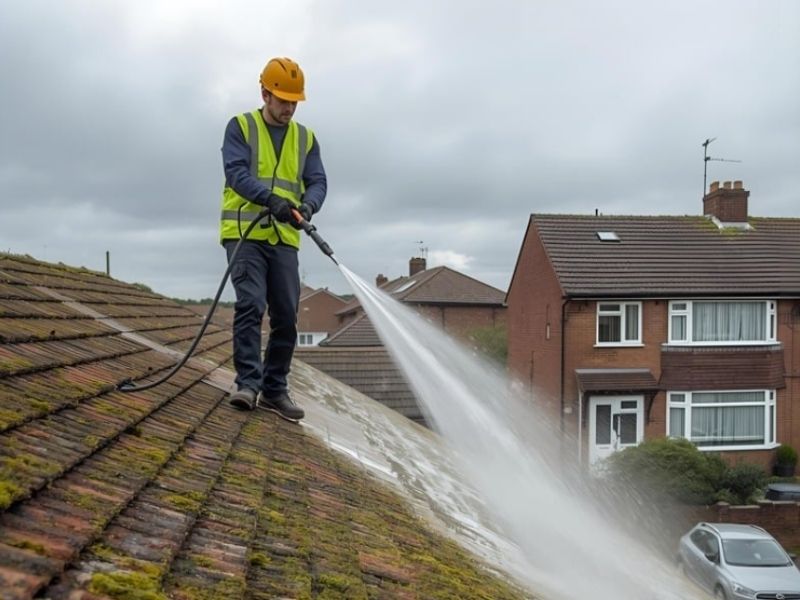
Pressure washing removes moss quickly but carries risks. High pressure jets can crack tiles, strip protective coatings from asphalt shingles, and force water under roofing materials where it causes leaks and moisture buildup.
If you use a pressure washer, keep the pressure below 1500 PSI and maintain distance from the surface. Hold the nozzle at a shallow angle, never pointing directly down at tiles. Work from the top down, rinsing debris toward gutters and downpipes.
Soft wash systems provide a safer alternative. These use low-pressure water combined with cleaning chemicals to break down moss without damaging the roof. Professional roof cleaning companies typically prefer soft wash methods because they remove moss effectively while protecting roofing materials.
Consider the age and condition of your roof before pressure washing. Older tiles, especially clay tiles, can crack or shatter under pressure. If you're unsure about your roof's structural integrity, consult professional help rather than risk causing damage.
Soft washing is currently the most recommended approach for removing moss from roofs. If you’re wondering what is soft wash roof cleaning, it is a technique that combines low-pressure water with specialist biocides that kill moss, algae, and spores without damaging tiles or shingles.
The cleaning process starts with applying a diluted biocide solution across the entire roof surface. The chemicals penetrate moss growth, breaking it down at the roots. After a short dwell time, gentle rinsing with water washes away dead moss and treats the roof against future colonisation.
This method works on all roofing materials including concrete tiles, slate, and composite shingles. It removes moss without stripping protective coatings or forcing water into vulnerable areas. The biocide continues working after cleaning, preventing new moss from taking hold.
Professional roof cleaning companies use specialised equipment for soft washing. They control water pressure precisely and mix chemicals at safe, effective concentrations. The results last longer than manual scraping or high-pressure washing, with treated surfaces staying clear for several years.
Steam cleaning kills moss and spores instantly using high-temperature water vapour. This chemical-free method appeals to property owners concerned about environmental impact or sensitive to cleaning chemicals.
Steam penetrates moss growth, destroying cell structures without physical scraping. It also sanitises the roof surface, removing bacteria and organic matter that support future moss development. The process leaves no chemical residues that might affect rainwater collection systems, which is often highlighted in discussions about roof steam cleaning versus scraping method because steam avoids the abrasion risks associated with manual tools.
However, steam cleaning costs 10 to 20 percent more than other methods due to specialist equipment and longer treatment times. It requires professional operators trained in using steam cleaners safely at height. Water consumption is higher than soft washing, and the initial kill may not prevent regrowth as effectively as chemical treatments.
For commercial properties where environmental credentials matter, steam cleaning offers a viable option. It works particularly well on hard surfaces like concrete tiles but may be less effective on porous materials where moss roots deeply.
Prevention is easier than repeatedly cleaning your roof. Several strategies reduce moss growth and extend the time between treatments, making them essential when learning how to stop moss growing on your roof.
Trim overhanging branches to increase sunlight exposure. More sunlight creates conditions where moss struggles to survive. This simple step can delay moss development by several years on roofs that were previously shaded.
Installing zinc or copper strips along the roof ridge provides ongoing protection. Metal particles released by rain create a surface that inhibits moss growth. These strips can prevent moss on new roofs and protect recently cleaned surfaces.
Regular inspections catch moss early when it's easiest to remove. Check your roof every six months, particularly after autumn when fallen leaves create favourable conditions. Remove loose debris promptly before it decomposes and feeds moss spores.
Keep gutters clear and functioning properly. Blocked drainage causes water to back up against roof edges, creating damp conditions where moss thrives. Clean gutters twice yearly, removing leaves and sediment that restrict water flow.
Apply a preventative biocide treatment after cleaning. These products soak into roofing materials and continue killing moss spores for years. They cost less than full cleaning and reduce the frequency of major maintenance work.
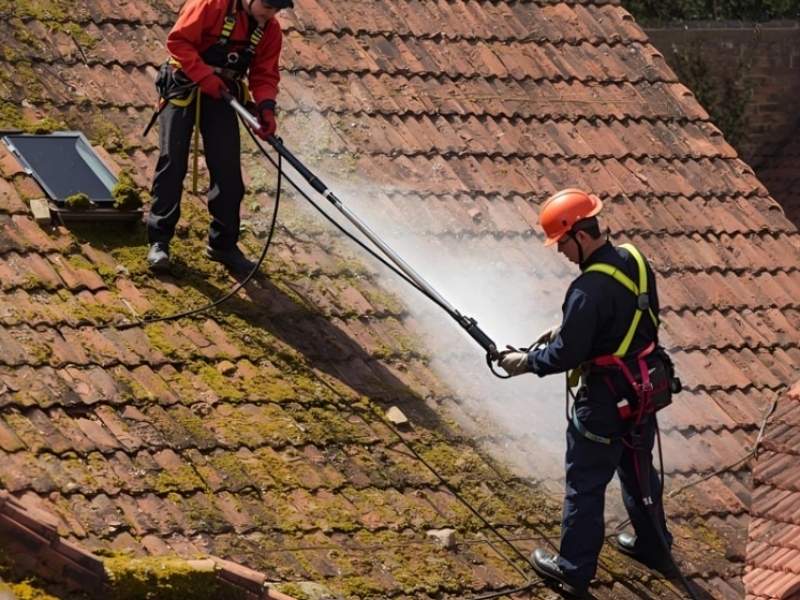
DIY moss removal works for small areas and single-storey buildings where access is straightforward. Larger properties, steep roofs, or extensive moss coverage justify hiring roof cleaning companies with proper equipment and insurance.
Professionals bring experience in treating different roofing materials safely. They know which cleaning chemicals work best on clay tiles versus asphalt shingles. They carry liability insurance covering accidental damage and work-related injuries.
Commercial properties almost always benefit from professional cleaning. The scale of commercial roofs makes DIY work impractical and unsafe. Regular maintenance contracts spread costs and ensure the roof remains in good condition year-round.
A professional service typically includes a full survey of your roof's condition, identification of any damage beyond moss growth, and advice on the most suitable removal process. They use safety equipment and follow health regulations that would be expensive for homeowners to replicate.
If you have concerns about working at height, underlying roof damage, or the effectiveness of your previous cleaning attempts, professional help provides peace of mind and better long-term results.
Manual moss removal costs only your time plus basic equipment like brushes and a garden hose. Expect to spend a full weekend on an average domestic property if you work carefully and safely.
Chemical treatments range from a few pounds for homemade solutions to £30-£50 for commercial biocides covering a typical roof. Factor in the cost of spray equipment if you don't already own a garden sprayer.
Professional cleaning for domestic properties usually costs between £200 and £800 depending on roof size, moss severity, and access difficulty. This includes labour, equipment, insurance, and disposal of waste materials. For homeowners wondering how much does roof cleaning cost in Newcastle, these figures provide a realistic guide to local pricing. Commercial buildings cost more based on square meterage and complexity.
Steam cleaning sits at the premium end, costing 10 to 20 percent more than standard professional cleaning. Soft wash treatments offer the best value for long-term results because they delay regrowth for four to six years.
Compare the cost of regular maintenance against replacing damaged tiles or repairing leaks caused by neglected moss growth. A well-maintained, moss-free roof can last five to 15 years longer than one left untreated, making cleaning a cost-saving investment.
Cleaning chemicals affect more than just moss. Biocides can harm plants, contaminate ponds, and impact local wildlife if they enter drainage systems. Choose products carefully and apply them responsibly.
Natural ingredients like white vinegar and dish soap reduce environmental impact but require more frequent applications. They work best on light moss growth rather than established colonies. For heavily affected roofs, commercial treatments balance effectiveness with responsible use.
Never allow cleaning chemicals to wash directly into storm drains or water courses. Use sheeting or barriers to catch runoff and divert it to appropriate drainage. Dilute concentrated products according to instructions to avoid using more than necessary.
Moss itself is not harmful to the environment when disposed of properly. Add it to compost heaps or green waste collections. Don't leave it on the ground where it can regrow or spread spores to other surfaces.
Wear protective equipment when handling any cleaning chemicals. Gloves, goggles, and long-sleeved clothing prevent skin contact and splashes. Work in well-ventilated conditions and avoid breathing spray mist.
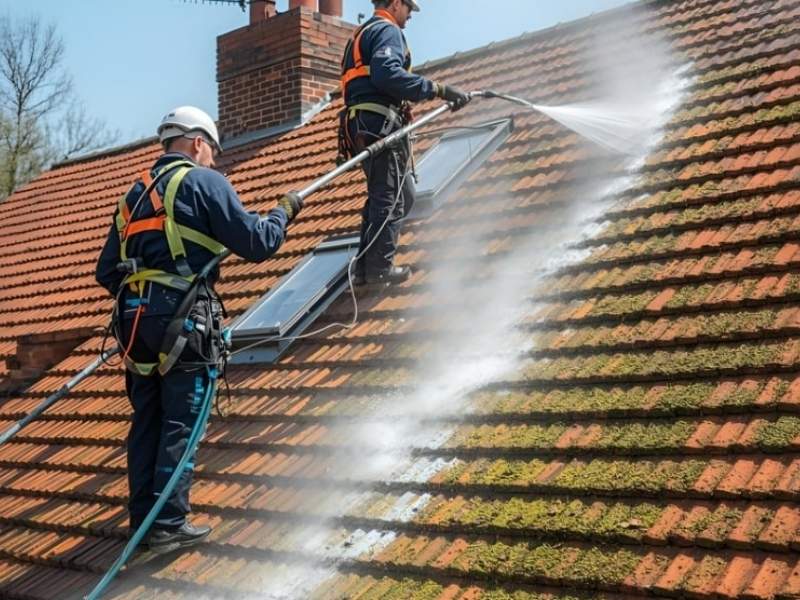
A clean roof stays that way with regular maintenance. Schedule annual inspections to catch moss before it becomes established. Many homeowners find that spring and autumn checks work well, coinciding with gutter cleaning.
Keep records of when you last cleaned the roof and which treatment you used. This helps you schedule follow-up work before moss returns. Moss tends to grow faster on north-facing and shaded roofs, sometimes becoming noticeable within two to three years of a previous clean.
Reapply preventative treatments as recommended by the manufacturer. Most biocides need renewal every four to six years to maintain effectiveness. Installing zinc or copper strips provides passive protection that works indefinitely once fitted. If you’ve ever wondered does roof cleaning extend the life of a roof, these preventative measures are exactly how homeowners achieve longer-lasting protection and avoid premature roof replacements.
Monitor changes around your property that might increase moss risk. New trees growing nearby, altered drainage patterns, or changes to neighbouring buildings can create shaded areas where moss grows more readily.
Document your roof's condition with photographs before and after cleaning. This creates a visual record showing improvement and helps identify problem areas that need extra attention in future treatments.
Keeping your roof moss free protects your property and extends the life of your roofing materials. Whether you choose DIY methods or professional cleaning, taking action now prevents more serious problems later.
At Roof Cleaning Newcastle, we specialise in safe, effective moss removal using soft wash techniques that treat moss at the root and prevent regrowth for years. We work with domestic and commercial clients across the region, providing fully insured services tailored to your roof's specific needs.
Contact Roof Cleaning Newcastle today for a free, no-obligation quote. Our experienced team will assess your property, recommend the best removal process, and give you a clear price with no hidden costs. Don't wait until moss damage becomes a major repair job—get in touch and protect your investment.